Moonbow is a reader-supported publication. It exists because of the support of generous readers like you! If you enjoy Moonbow, the best ways you can support it is to subscribe, share this newsletter with a friend, and consider upgrading to a paid subscription.
In 1980, the radical rock-pop-experimental band Devo released their third album, Freedom of Choice, which included one of their most well-known and controversial songs, “Whip It.” Even if you don’t remember the song, I bet you remember the hats. Those iconic plastic red pyramid-shaped hats, often referred to as flower pots by unknowing fans, were designed by Devo’s Jerry Casale and Mark Mothersbaugh as domes meant to collect Orgone energy—which, according to pseudoscience, is the universal life force—and when it escapes from the crown of the head, the dome pushes it back into the medulla oblongata for increased mental energy. Devo and their weird hats were misunderstood as novelties, but those hats represent Devo’s philosophy of De-evolution—the belief that society is on a downward spiral, that we’re regressing rather than evolving.
Unfortunately, the devolution of humans feels all too real these days. From the era of Trumpism to the rapid, damaging effects of climate change to the global pandemic, each new year is somehow worse than the last. And in March of 2020, forty years after its release, Freedom of Choice felt more relevant than ever. But it’s not all doom and gloom; Devo’s subversive, satirical music and visual artistry are meant to wake us up! The titular song is about how people claim they want the power of choice when really they like to be told what to do. They crave complacency. But when the pandemic shut down society at the beginning of 2020, our freedoms were suddenly ripped away. It was clear that in order to evolve, we needed to get creative.
For parents, the pandemic was especially tricky. When schools closed that March, parents and caregivers suddenly became responsible for every part of their child’s social and developmental skills. But they also had jobs to do, elders to take care of, and houses to clean—all while juggling the fear that civilization was on the verge of collapse. It was no small feat. Thankfully, books and the amazing people who make them were there to help children (and their floundering parents) during this incredibly precarious time. One valuable resource my family used was "Mac's Book Club Show Book Club,” a virtual club on Instagram where the children’s book author, Mac Barnett, read his books (and a few books not by him) to kids. Every day at noon California time, people from all seven continents joined together over a shared love of reading. There are no club rules, except maybe hats—hats aren’t required, but they’re encouraged. But what if you don’t have a hat? Could a shoe be a hat? Could the bread crust from your sandwich be a hat? According to Barnett, it’s a hat if you believe it. This small, silly idea became an act of radical hope. We still had some freedom of choice, even if that meant wearing leftovers on our heads.
Very Good Hats (2022)
Written by Emma Straub and illustrated by Blanca Gómez
One “Mac’s Book Club Show Book Club” member is best-selling novelist, bookstore owner, and mother-of-two Emma Straub, who just wrote her first picture book, Very Good Hats (2022), illustrated by Blanca Gómez. The book’s beautiful cover is wonderfully diverse, both in hats and the humans who wear them, but it’s also deceiving: this is not a book simply about a hat’s utilitarian functions; it’s a book that champions creativity, joy, silliness, hope and that anything—literally anything—can be a hat.
Like Barnett, Straub is an ambassador for make-believe. It’s a hat if you believe it. You have the power to make yourself believe. Children are much better at this than adults, but even they sometimes need a little encouragement. Very Good Hats opens with the lines, “Do you know what a hat is? I bet you think you know what a hat is.” Right away, preconceived notions are challenged. In this inventive book, even heads aren’t required for hats. Can a finger wear a hat? Of course it can. Is there any kid out there who hasn’t worn raspberries (or, in my case, black olives) on their fingertips? Maybe, but maybe those kids are the ones who use chewed-up gum, tortellini, acorns, or doll shoes. What about animals? Is a turtle’s shell its hat? Possibly! Is the roof of a house its hat? Duh, everyone knows that.
I can’t help but wonder if the book club inspired Straub to write this book. I don’t know the origin story. What I do know is that encouraging imaginative, flexible ways of thinking and seeing is important, possibly more than ever. A book promoting wearing pajama pants as a hat may seem trivial, but the freedom of choice, thinking outside the box, and challenging the status quo are some of our most valuable rights as humans. Wearing bubbles as a hat is similar to wearing red energy domes. It’s less about the hat and more about the belief that a hat can enhance creativity and be an agent for change—not just for yourself but for humankind and possibly even the planet.
So tell us something we don't know
Stop digging down, the same dark hole
They stole that treasure long ago
So long ago, nobody knows
How to find something new and bright
Some treasure hiding in plain sight
A humming shocking lost delight
Wrapped in a message of hope
In a message of hope
“Message of Hope” by Devo (2013)
My kids in 2020.
You can buy Very Good Hats at your local independent bookstore or bookshop.org
More Very Good Hats
There’s no shortage of hat books for children! Here are some of my favorites.
Madeline and the Bad Hat (1956)
by Ludwig Bemelmans
I appreciate books that feature tricksters and naughty children. We all know those kids. We may have one of those kids. We may be one of those kids. Those “Bad Hat” kids will often surprise you—like Pepito—who does terrible things but then learns from his mistakes. I guess being mauled by a pack of wild dogs will do that to a kid.
My Friends the Frogs (1989)
by James Marshall
A collection of funny stories, a poem (“The Lost Cat” by Shel Silverstein), a fairy tale (The Gingerbread Man), and DIY instructions on how to make a hat. The title may be misleading to some. Not everyone gets Marshall’s books. Here’s an angry review from an adult reader on Amazon.
“Had nothing to do with Frogs , it was all about hats and than the end was The Gingerbread A hole with no words. Thanks alot ruined the night.”
I think it’s great. Well done, Marshall.
The Hat (1970)
by Tomi Ungerer
"Thunder of Sebastopole! That hat is alive!”
I’d buy this book simply for the name of its protagonist: Benito Badoglio. Great name! Like many of Ungerer’s books, this book takes great pleasure in wielding playful language. It also employs Ungerer’s signature graphic charm, brilliantly weaving violence and debauchery with magic and whimsy. The Hat is an exuberant fairy-tale-like story of heroism that’s a blast to read out loud with kids.
Wonder Bear (2008)
by Tao Nyeu
In a review of Wonder Bear by Publisher’s Weekly, they wrote, “Nyeu's art makes a strong impression; it just doesn't tell much of a story.” This infuriated me. How could they get it so wrong? This is a picture book with the ability to tell endless stories. Clearly, this reviewer lacks imagination, or maybe this reviewer forgot to read this book to children. Ask kids about this book, and you’ll be overwhelmed by the stories they tell.
Wonder Bear is a wordless picture book—which is probably why this reviewer struggled with it. It requires participation. The illustrations are gorgeous! Two young children plant mysterious seeds that grow into an enormous flowering vine that blooms into a giant bear in a blue top hat. Like Mary Poppins’ magic bag, the bear has a magic hat that takes the children on an enchanting journey filled with fascinating creatures. But this adventure isn’t just for the kids in the book. It’s an immersive tale that turns its readers into storytellers. You just have to ask them.
Carol and the Pickle Toad (2021)
By Esmé Shapiro
Not everyone wears a toad as a hat, but Carol does! The problem is her hat is really bossy, making it difficult for Carol to make decisions for herself. That is until a pigeon steals her hat and leaves her to discover her true inner voice. It’s a quirky and playful story of self-discovery and creativity.
Also: aside from the whole bossy part, frogs make excellent-looking hats.
Jon Klassen’s Hat Books
Jon Klassen wears many hats. So do the characters in his books. You’ve probably heard of them. It started with his first picture book, I Want My Hat Back (2011). A bear has lost his hat, and he wants it back. In This Is Not My Hat (2012), a fish steals a hat from a whale. Will he get away with it? And in We Found a Hat (2016), two turtles find a hat, but it looks good on both of them. Who will get to keep it? Klassen’s books are incredibly popular with children and adults (and critics!). They’re hilarious and mischievous—but in Klassen’s signature understated style.
My favorite thing about Klassen’s books, including his latest, The Rock from the Sky (2021), is their quiet thrill. The artwork, the humor, the psychological depth—it’s often subtly introduced or gently implied, even when someone is eaten alive.
You can buy his hat books as a set: Jon Klassen Hat Box.
More Hats!
Jennie’s Hat by Ezra Jack Keats (1966)
Mae Makes the Way: The True Story of Mae Reeves, Hat & History Maker written by Olugbemisola Rhuday-Perkovich and illustrated by Andrea Pippins (2022)
A Bear Called Paddington written by Michael Bond and illustrated by Peggy Fortnum (1960)
When Everybody Wore a Hat by William Steig (2005)
The Upside Down Hat written by Stephen Barr and illustrated by Gracey Zhang (2022)
Caps for Sale by Esphyr Slobodkina (1940)
Finn Family Moomintroll by Tove Jansson (1948)
Courage Hats written by Kate Hoefler and illustrated by Jessixa Bagley (2022)
Dog & Hat and the Lost Polka Dots by Darin Shuler (2022)







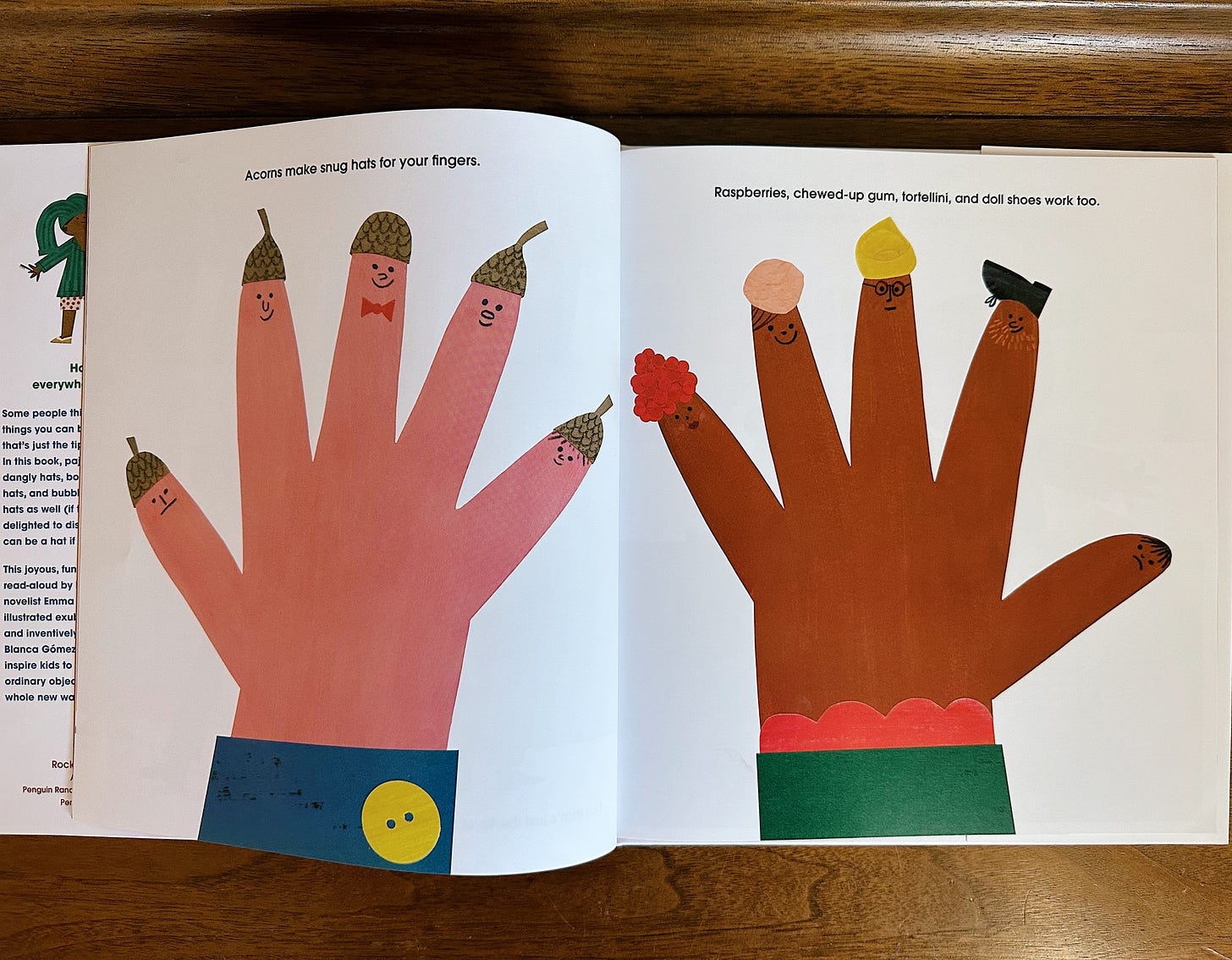
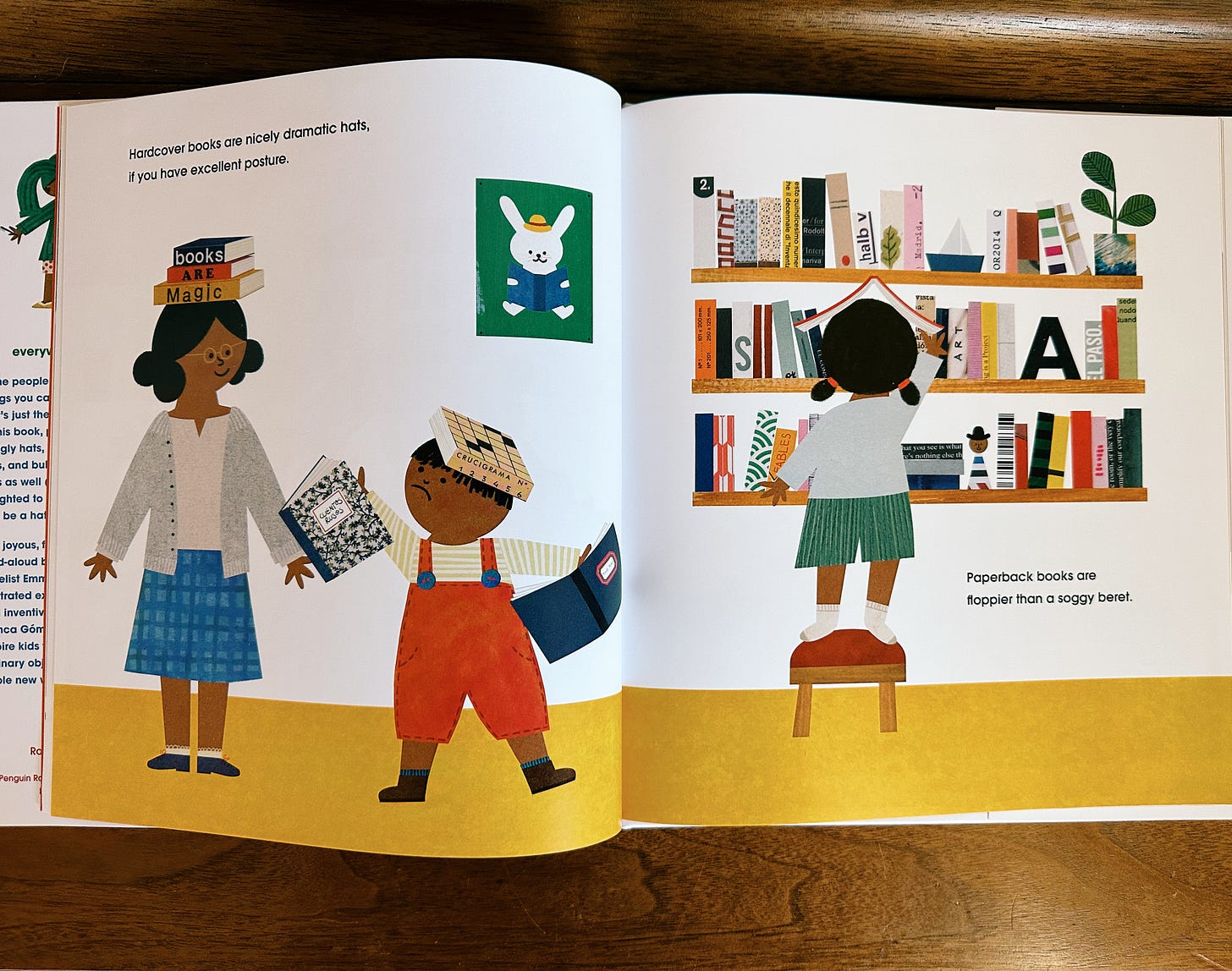
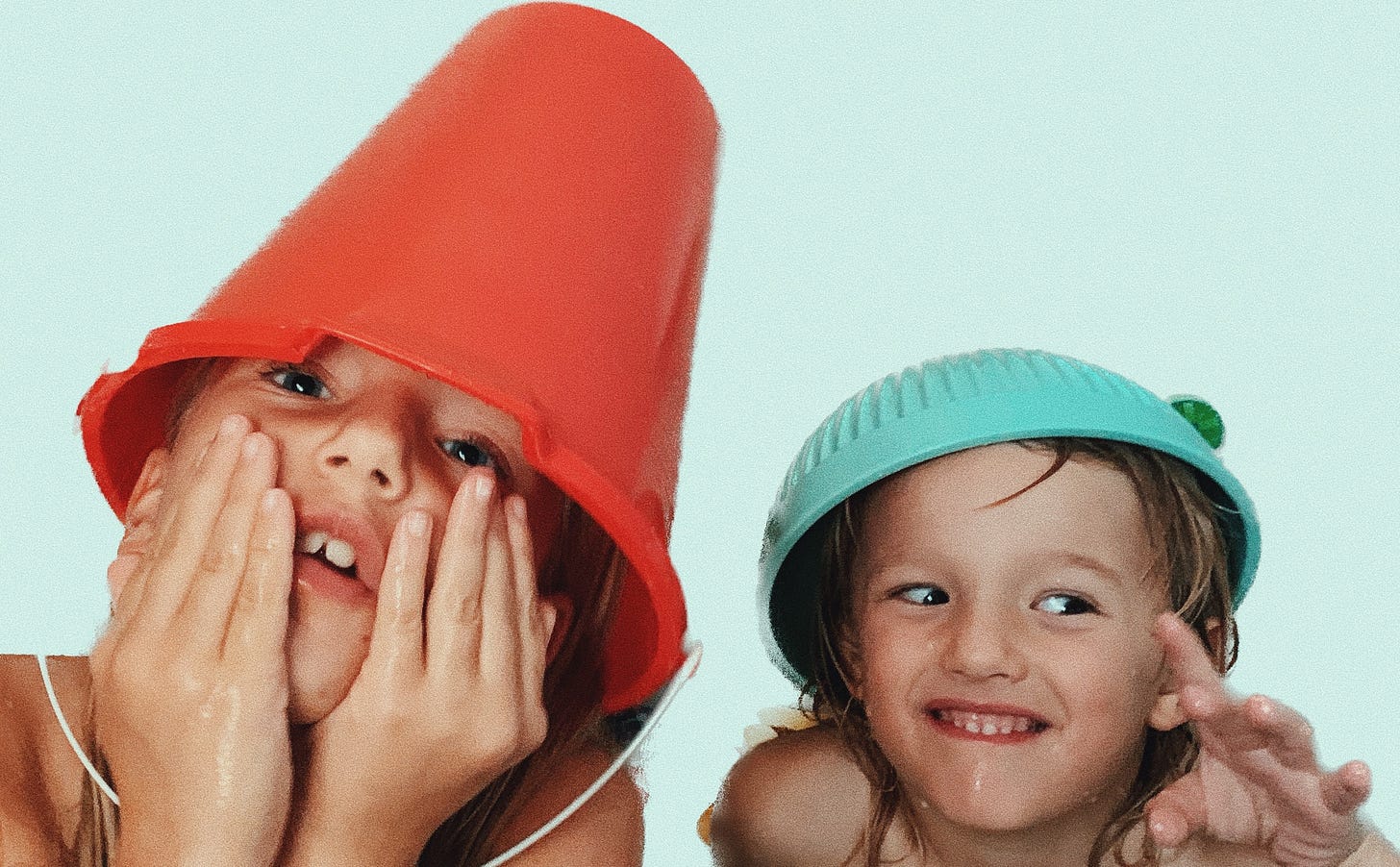
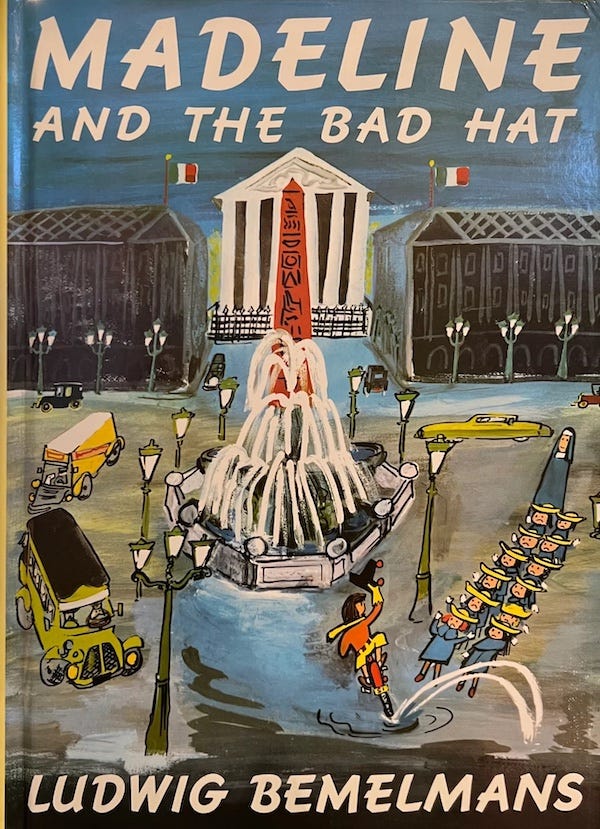

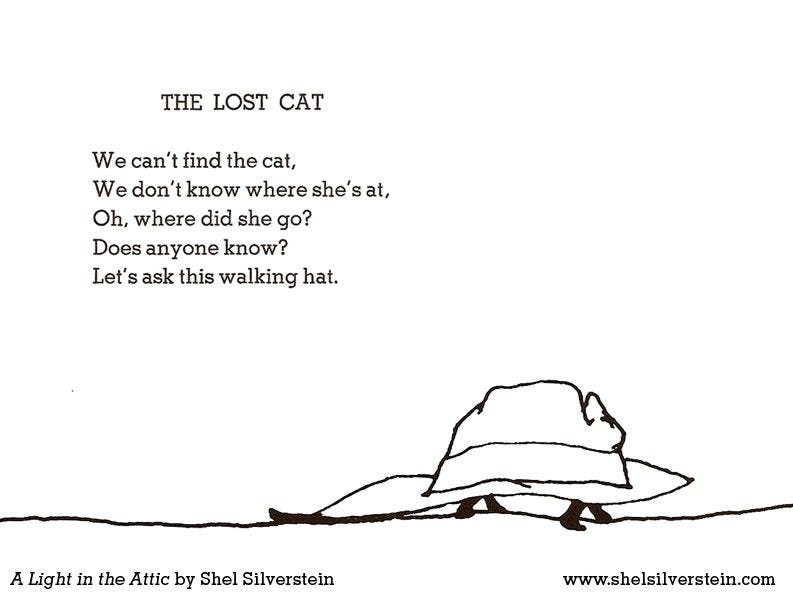
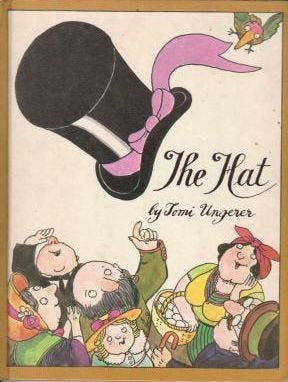

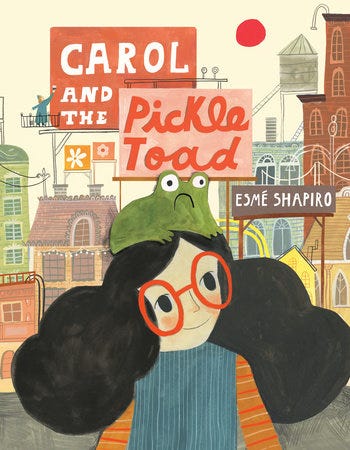


So many great titles I can't wait to check. Thank you!
Hats! I love this. Awesome job, as usual, Taylor.